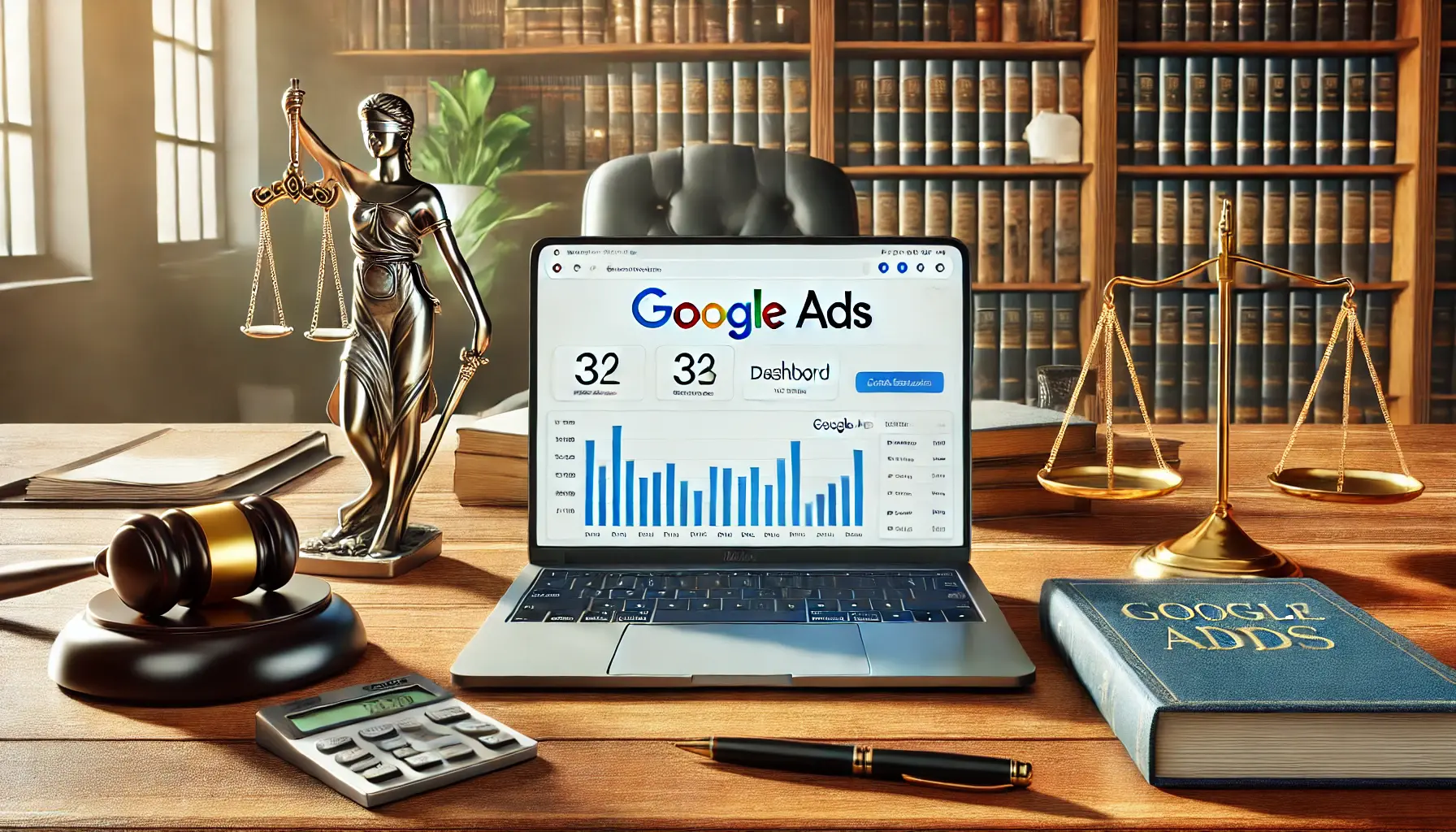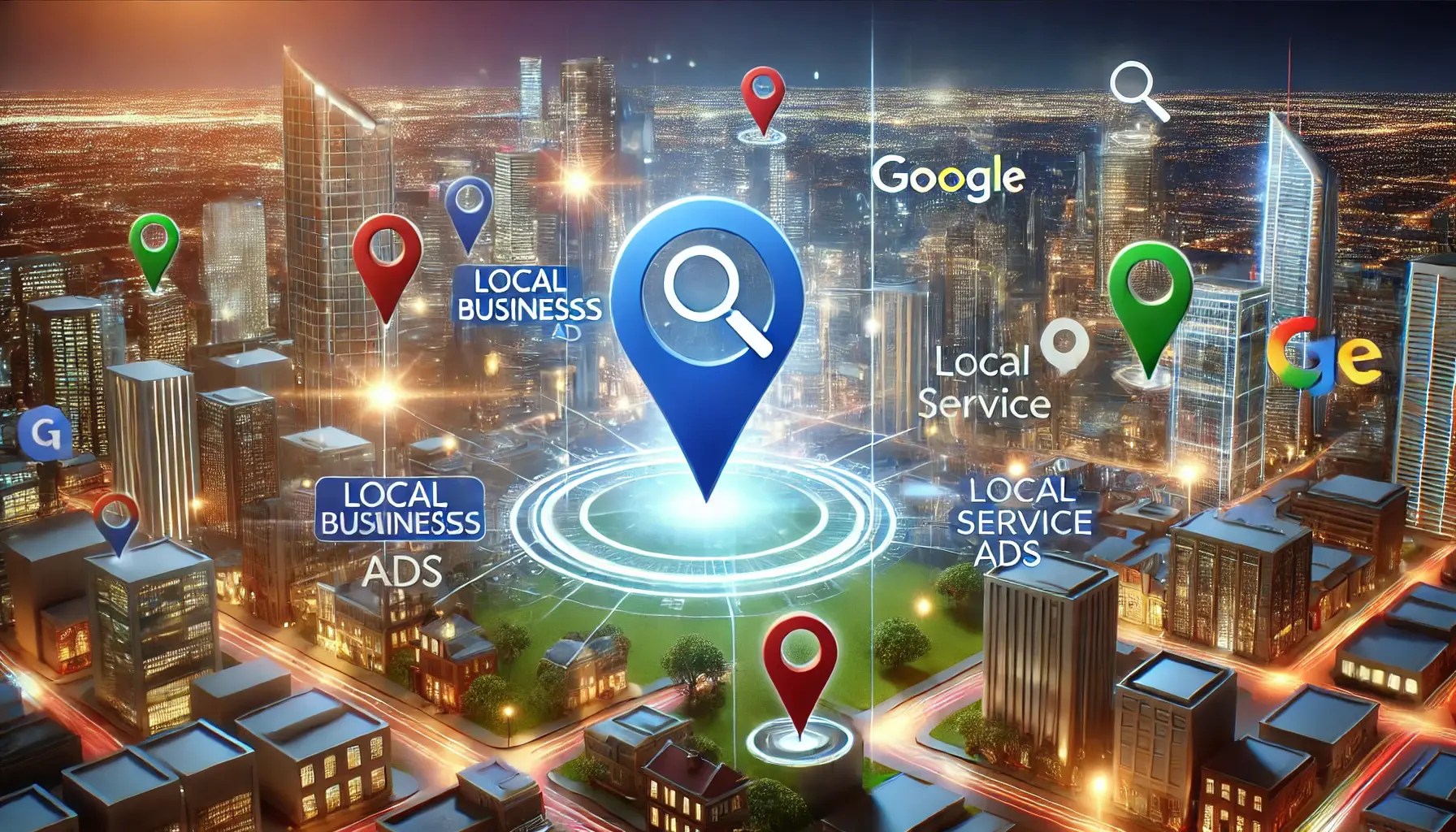Each decision you make in managing Google Ads campaigns significantly affects performance and results.
Whether targeting new audiences or refining your budget, Google Ads offers a variety of ways to tune up your strategies.
Among them, and standing out in automating the process, is the feature known as Auto-Apply Recommendations.
This powerful tool, powered by machine learningA branch of artificial intelligence (AI) that enables systems to learn and improve from experience without being explicitly programmed., helps marketers streamline their campaigns by automatically applying what Google considers the best suggestions to improve ads.
But how do you get the most from this feature while retaining control over your advertising efforts?
In this article, we dive deep into how Auto-Apply Recommendations work in Google Ads and ways you can use them to improve your campaign performance.
- What Are Auto-Apply Recommendations in Google Ads?
- Types of Auto-Apply Recommendations Available
- How to Enable and Manage Auto-Apply Recommendations
- Pros and Cons of Auto-Apply Recommendations
- Best Ways to Leverage Auto-Apply Recommendations
- Maximizing Campaign Success with Auto-Apply Recommendations
- Frequently Asked Questions About Auto-Apply Recommendations
What Are Auto-Apply Recommendations in Google Ads?
Auto-Apply Recommendations in Google Ads are a set of tools designed to help every advertiser increase the performance of their campaigns by automatically applying optimization proposals from Google.
It deploys Google’s machine learning algorithmsA set of rules or calculations followed by a computer to perform problem-solving operations., which analyze your ad performance, audience targeting, and bidding strategies, to make improvements that align with best practices.
These improvements can range from budget allocation to ad copy enhancements, keeping you competitive and efficient in your campaigns.
Google Ads offers many recommendations, but not all are automatically applied.
However, with the Auto-Apply Recommendations feature, you have the option to let Google handle certain adjustments for you, saving time and helping improve performance.
This feature ensures that your campaigns remain optimized, even when you’re not actively managing them.
One of the major benefits of using Auto-Apply Recommendations is that it allows you to automate repetitive tasks, such as adjusting bids or testing new ad formats, without risking human error.
Instead of manually reviewing every recommendation, you can configure the system to automatically apply suggestions that align with your business goals.
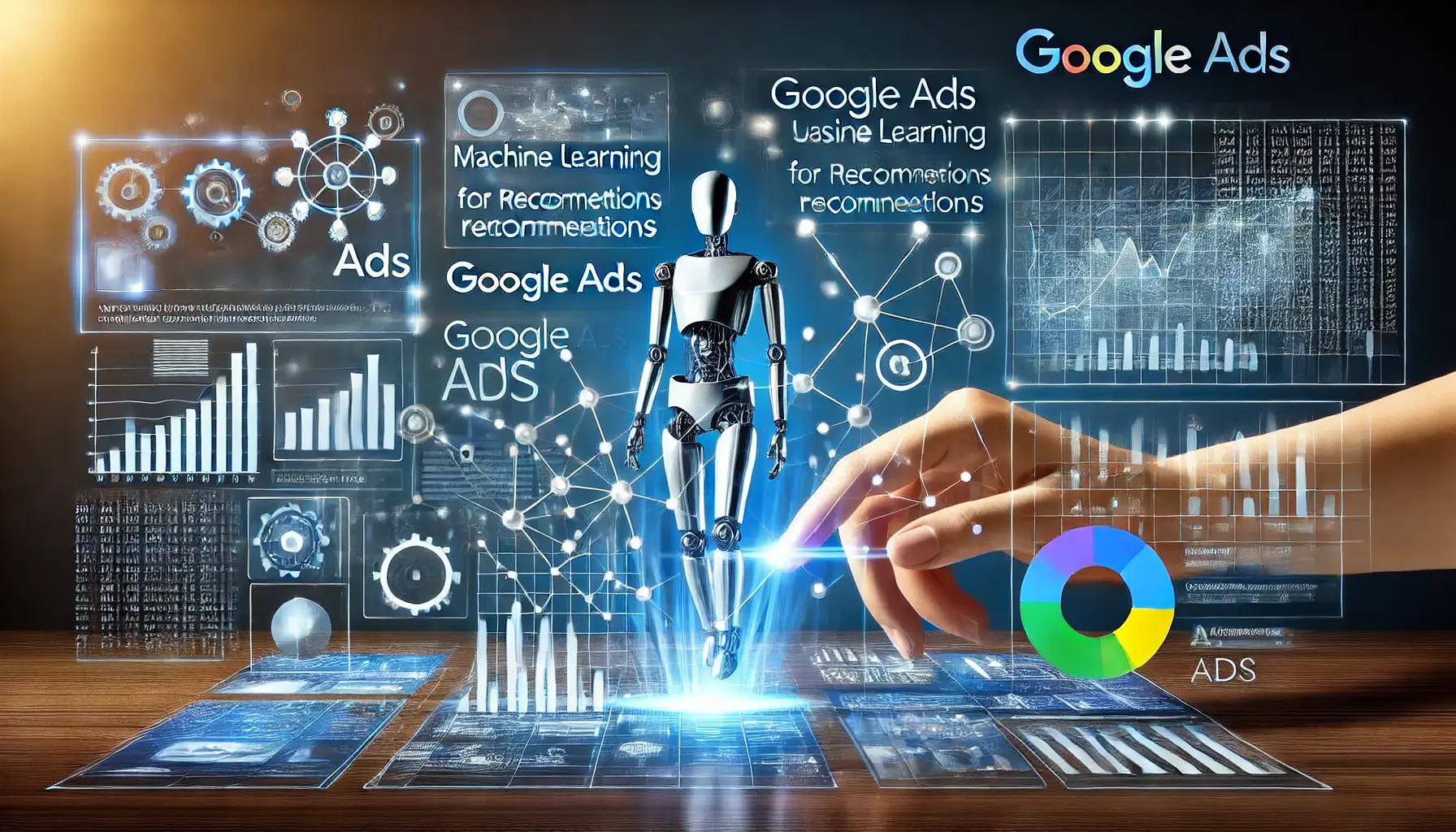
Machine learning in Google Ads processing data for optimized recommendations.
How Google Ads Uses Machine Learning for Recommendations
Google’s machine learning plays a crucial role in Auto-Apply Recommendations.
It analyzes vast amounts of data, including previous ad performance, competitor campaigns, and user behavior trends, to generate personalized recommendations for your account.
As the algorithm continuously learns from successes and failures, the relevance and impact of its suggestions improve over time.
For example, if your ads underperform during peak hours, Google may recommend increasing your bids or adjusting your targeting.
With Auto-Apply Recommendations, these changes can be made automatically, potentially boosting your return on investment (ROIReturn on Investment, a measure used to evaluate the efficiency or profitability of an investment.) without any manual intervention.

Auto-apply recommendations streamline ad performance, highlighting efficiency and automation for advertisers.
Why Auto-Apply Recommendations Matter for Advertisers
Managing multiple campaigns can be time-consuming, especially for businesses with limited resources.
The Auto-Apply Recommendations feature addresses this challenge by allowing advertisers to automate optimizations, freeing up time to focus on more strategic tasks.
This not only saves time but also ensures that campaigns are always performing at their best.
Additionally, because these recommendations are based on real-time data and insights, your campaigns can respond quickly to market changes.
Whether it’s adjusting bids, optimizing ad placement, or testing new formats, Auto-Apply Recommendations keep you competitive without requiring constant hands-on management.
Auto-Apply Recommendations automate ad performance optimization, reducing manual effort and improving results based on Google’s machine learning insights.
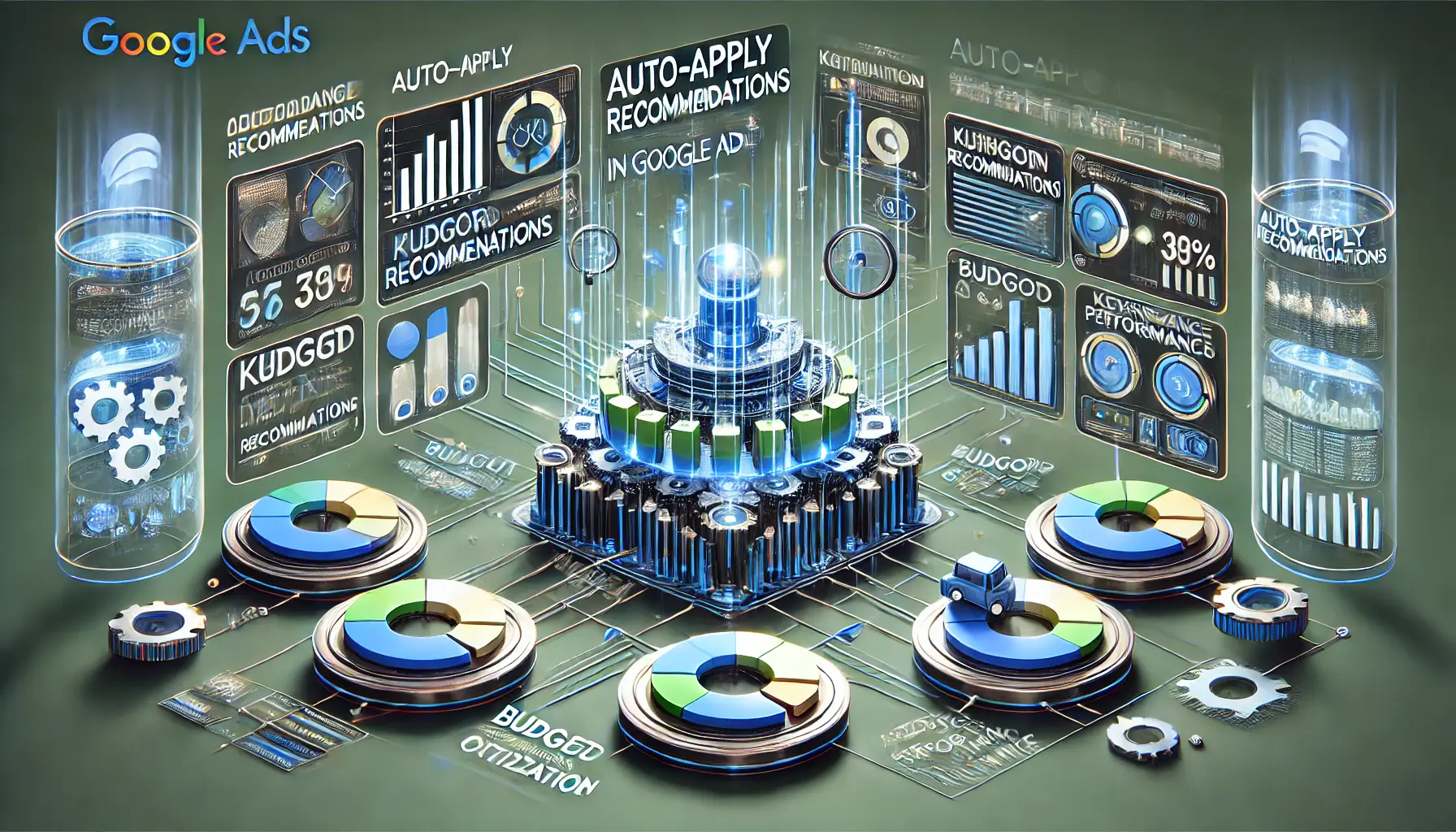
Different types of auto-apply recommendations, including budget allocation and keyword optimization, in Google Ads.
Types of Auto-Apply Recommendations Available
Google Ads offers different types of Auto-Apply Recommendations, each applicable to various parts of campaign management.
These recommendations enhance various components of an advertiser’s campaigns, ranging from budget management to ad copy improvements.
Applying the right recommendations allows you to manage your campaigns more efficiently and ensure maximum performance.
The following are the major types of Auto-Apply Recommendations available in Google Ads:
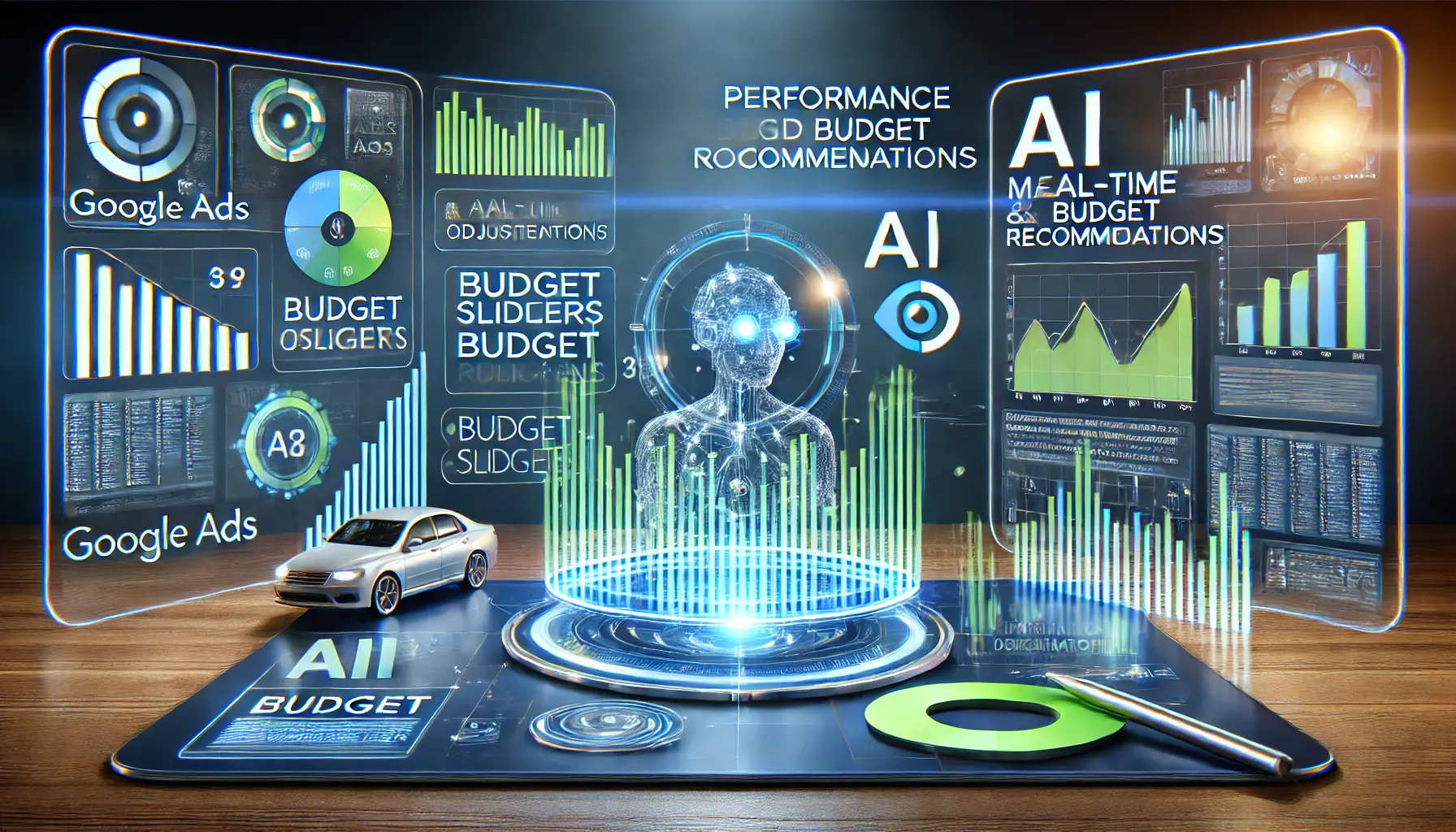
Performance and budget recommendations optimizing campaigns through real-time data adjustments in Google Ads.
Performance and Budget Recommendations
Google focuses on critical areas like performance and budget optimization.
Under this category, an Auto-Apply Recommendation may suggest increasing your budget if your campaigns are limited by budget or reallocating budget between high-performing and low-performing campaigns.
These recommendations help maximize your return on investment by ensuring that your budget is optimally allocated.
Other examples include:
- Increasing daily budgets when there is a high probability of receiving more clicks or conversions.
- Reducing spend on poorly performing keywords or ad groups.
- Allocating more budget to campaigns with a higher likelihood of meeting your goals based on historical data.

Targeting and keyword optimization improving ad performance through AI-driven audience segmentation and keyword adjustments.
Targeting and Keyword Optimization
Targeting and keyword optimization are crucial for reaching your ideal audience at the perfect time.
Auto-Apply Recommendations from Google may suggest adding new keywords that will attract high traffic or pausing low-performing keywords that drive no results.
These recommendations also help fine-tune your audience targeting by analyzing user behavior and making changes based on real-time data.
Recommendations in this category include:
- Adding negative keywords to filter out irrelevant traffic and avoid wasted ad spend.
- Expanding keyword match types to increase visibility across a broader range of search queries.
- Adjusting bids for specific keywords based on their performance.

AI-driven ad copy and creative suggestions optimizing Google Ads performance.
Ad Copy and Creative Suggestions
Ad copy and creatives are the face of your campaigns, and their optimization is crucial for campaign success.
Google’s Auto-Apply Recommendations can suggest tweaking ad headlines, descriptions, or even the structure of your ads to improve delivery.
These suggestions are often based on factors such as click-through rates, conversion rates, or user engagement metrics.
Common ad copy and creative recommendations include:
- Updating ad headlines to reflect trending or top-performing keywords.
- Testing various ad formats, such as responsive search ads or image extensions.
- Enhancing call-to-action phrases to make them more appealing.

Automated bid and campaign adjustments optimizing Google Ads performance in real-time.
Bid and Campaign Adjustments
Bidding strategies are crucial for optimizing your Google Ads campaigns.
Auto-Apply Recommendations in this area may suggest switching to automated bidding strategies, such as Target CPACost Per Acquisition, a bidding strategy where advertisers pay only when a user completes a specific action, such as making a purchase or signing up. or Maximize ConversionsAn automated bidding strategy in Google Ads that adjusts bids to get the most conversions within your budget., to achieve better results with less manual oversight.
These recommendations help ensure that your bids align with both your campaign goals and real-time market conditions.
- Switching to automated bidding strategies instead of manual bidding to improve performance.
- Adjusting bids based on device, location, or time of day performance.
- Lowering bids for keywords that consistently underperform or have low conversion rates.
By leveraging these types of Auto-Apply Recommendations, you can automate many aspects of your Google Ads campaigns, freeing up time to focus on more strategic tasks while still optimizing ad performance.
Performance and budget recommendations can automatically adjust daily budgets, ensuring you’re making the most of your ad spend by targeting high-performing campaigns.
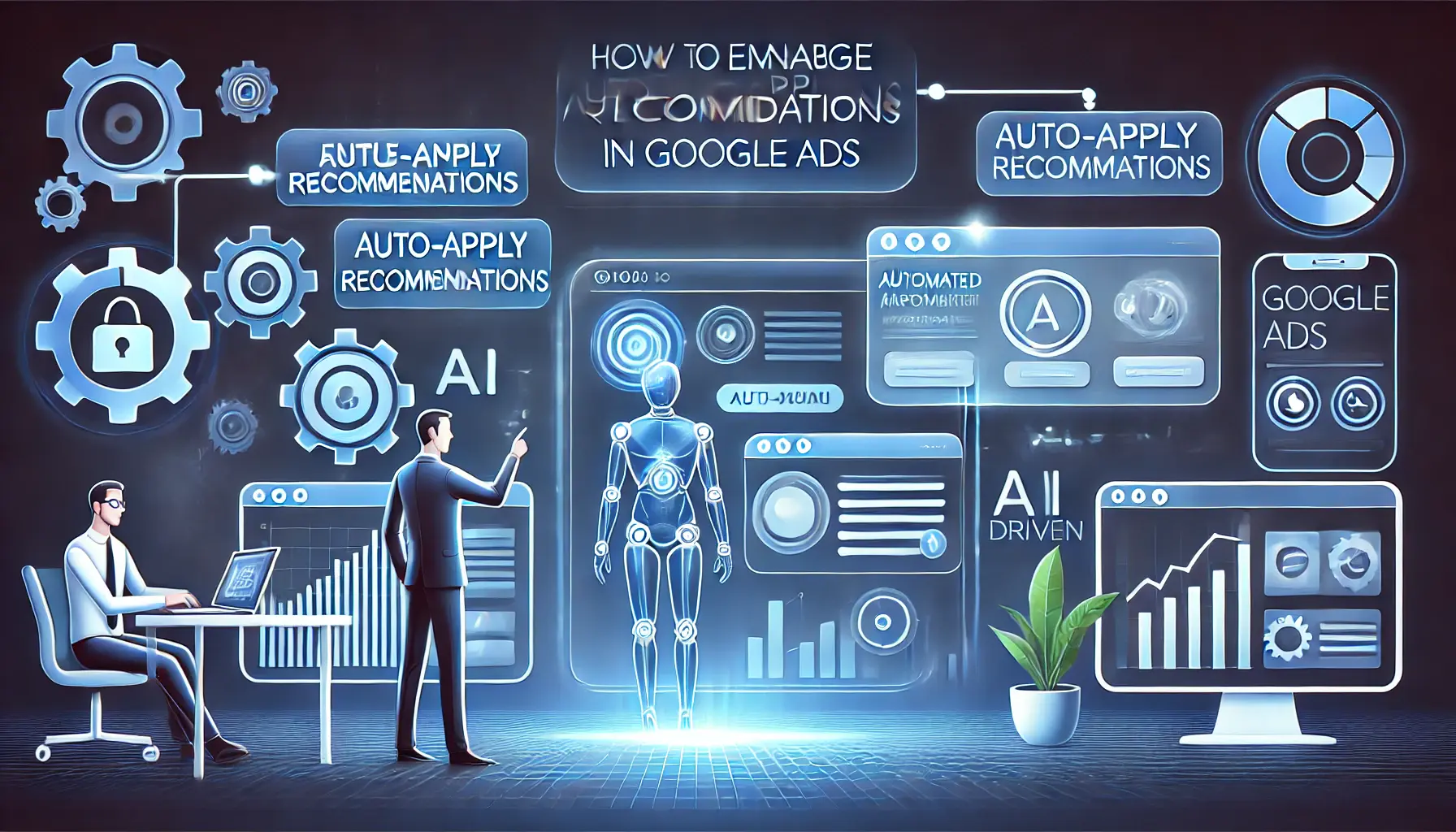
Enabling and managing auto-apply recommendations through a digital marketing dashboard in Google Ads.
How to Enable and Manage Auto-Apply Recommendations
Auto-Apply Recommendations in Google Ads can ease managing ads, but the process needs to be fully understood so that the recommendations align with your business objectives.
When set up correctly, you can automate certain tasks while maintaining control over your campaign’s performance.
Here’s how you can enable and manage this feature effectively:
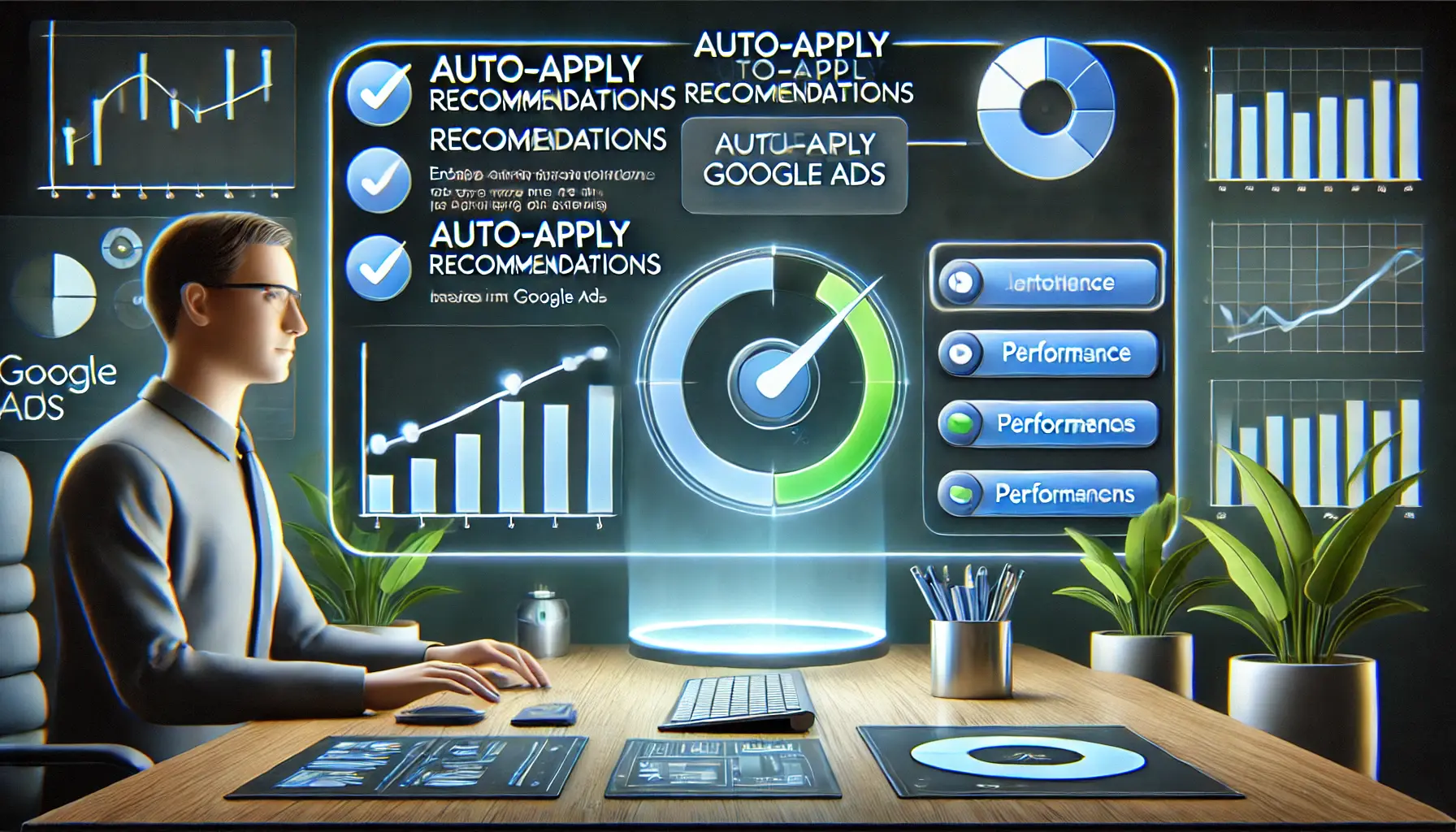
Enabling auto-apply recommendations through a step-by-step process in Google Ads dashboard.
Steps to Enable Auto-Apply Recommendations
To use Auto-Apply Recommendations for the first time, follow these steps:
- Open your Google Ads account and click the ‘Recommendations’ tab.
- On the right side of the page, click ‘Manage’ at the top to access the Auto-Apply settings.
- Select which recommendation types you want to automatically apply, such as budget adjustments, bid optimizations, or keyword suggestions.
- Preview and confirm your selection, ensuring that the recommendations are compatible with your advertising strategy.
- Once confirmed, Google will automatically apply the selected recommendations to your campaigns.
It’s important to note that you can customize which types of recommendations are auto-applied.
For example, you might want Google to manage budget adjustments while keeping manual control over ad copy changes.
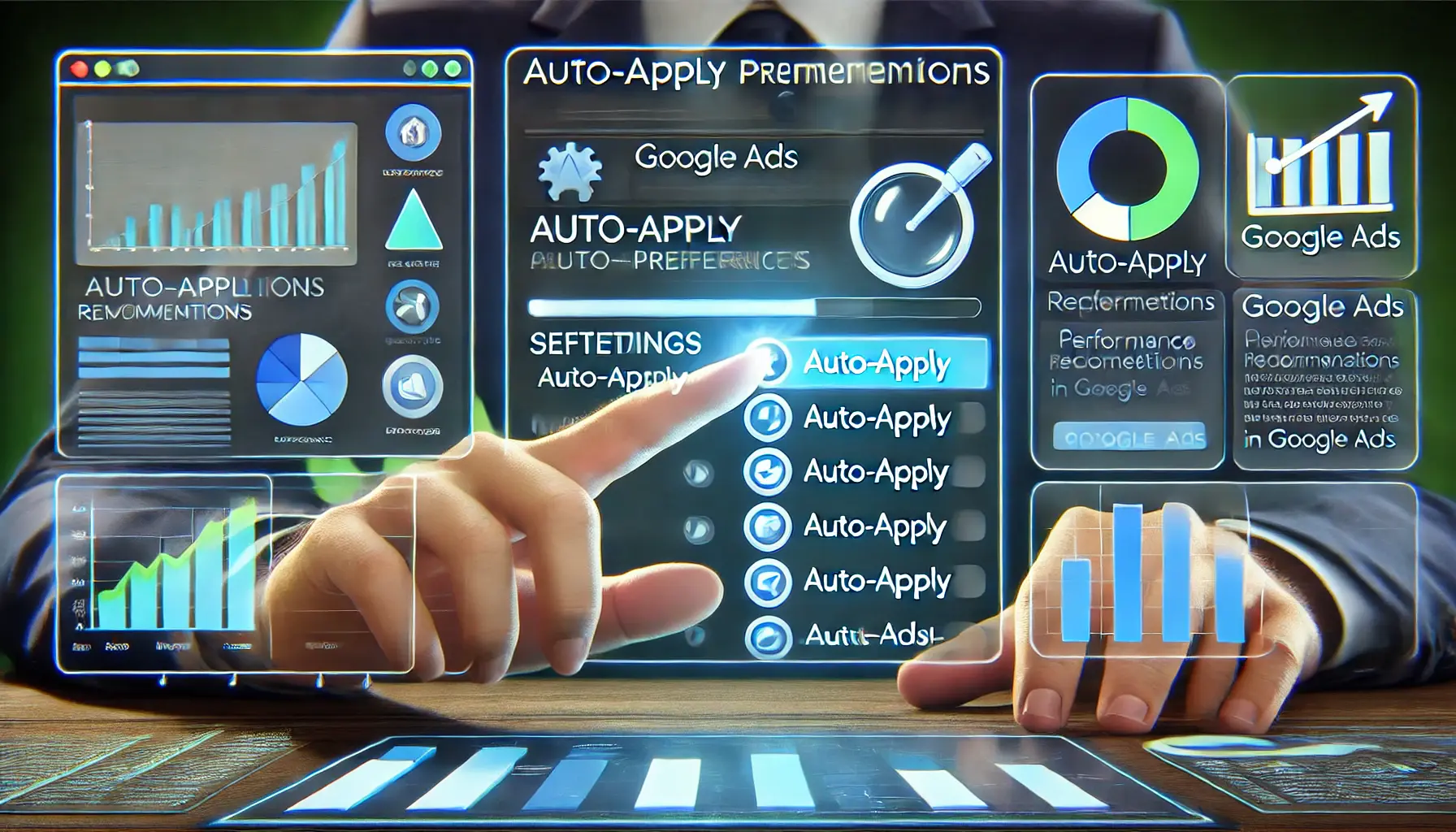
Customizing auto-apply preferences in Google Ads to optimize campaign performance.
Customizing Auto-Apply Preferences
Not every recommendation will suit your business needs, so it’s important to personalize your preferences.
You can select the type of recommendations to auto-apply based on your goals.
For instance, if conversions are your primary objective, you can focus on bid optimizations and keyword match type changes.
At the same time, if you prefer having creative control over your messaging, you may choose not to auto-apply ad copy changes.
- Choose recommendations that align with your business objectives, such as higher ROI, more clicks, or better targeting.
- Turn off any auto-applied recommendations that don’t fit your campaign’s strategy.
- Periodically review your Auto-Apply settings to ensure they still match your current goals.
Tracking changes made by auto-apply recommendations in Google Ads through performance metrics and analytics.
Tracking Changes Made by Auto-Apply
One of the most important aspects of managing Auto-Apply Recommendations is keeping track of the changes made by the system.
Google Ads provides detailed reports on what recommendations were applied, when they were applied, and their impact on performance.
These reports help you determine whether the automated changes are working in your favor.
To track changes:
- Go to ‘Change History’ in your Google Ads dashboard.
- Filter for ‘Recommendations Applied’ to see exactly what changes Google has made.
- Evaluate performance metrics tied to these changes, such as improved conversion rates, CTR, or reduced cost-per-click.
By tracking these updates, you can quickly assess whether the automated changes are driving the desired results or if further manual adjustments are needed.
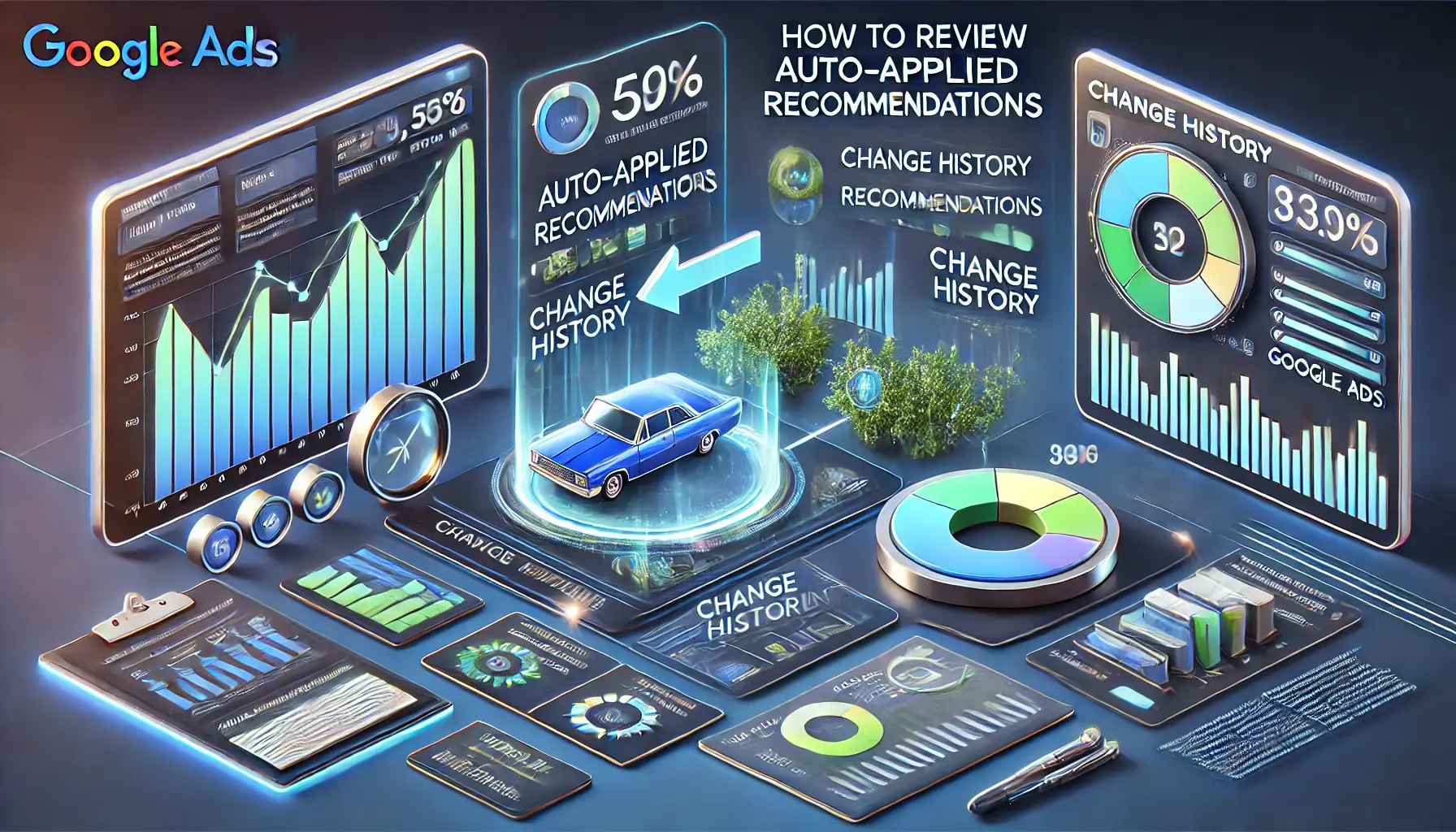
Reviewing auto-applied recommendations in Google Ads using performance metrics and change history.
How to Review Auto-Applied Recommendations
Even with Auto-Apply Recommendations turned on, it is important to periodically review these recommendations.
While the automated system can handle many changes, strategic oversight is necessary to ensure that the applied recommendations continue to align with your overall campaign goals.
To review applied recommendations:
- In your Google Ads account, open the ‘Recommendations’ tab.
- Under ‘Auto-Applied Recommendations,’ you’ll find a list of the changes that have occurred.
- Evaluate the performance impact of these changes to see if key metrics have improved.
- Make any necessary adjustments if certain recommendations did not deliver the expected results.
Regular reviews will help you maintain the right balance between automation and manual control, ensuring your campaigns remain both efficient and effective.
Enable Auto-Apply Recommendations by customizing settings to automate specific tasks such as bid adjustments or keyword changes, but maintain oversight to ensure alignment with your strategy.
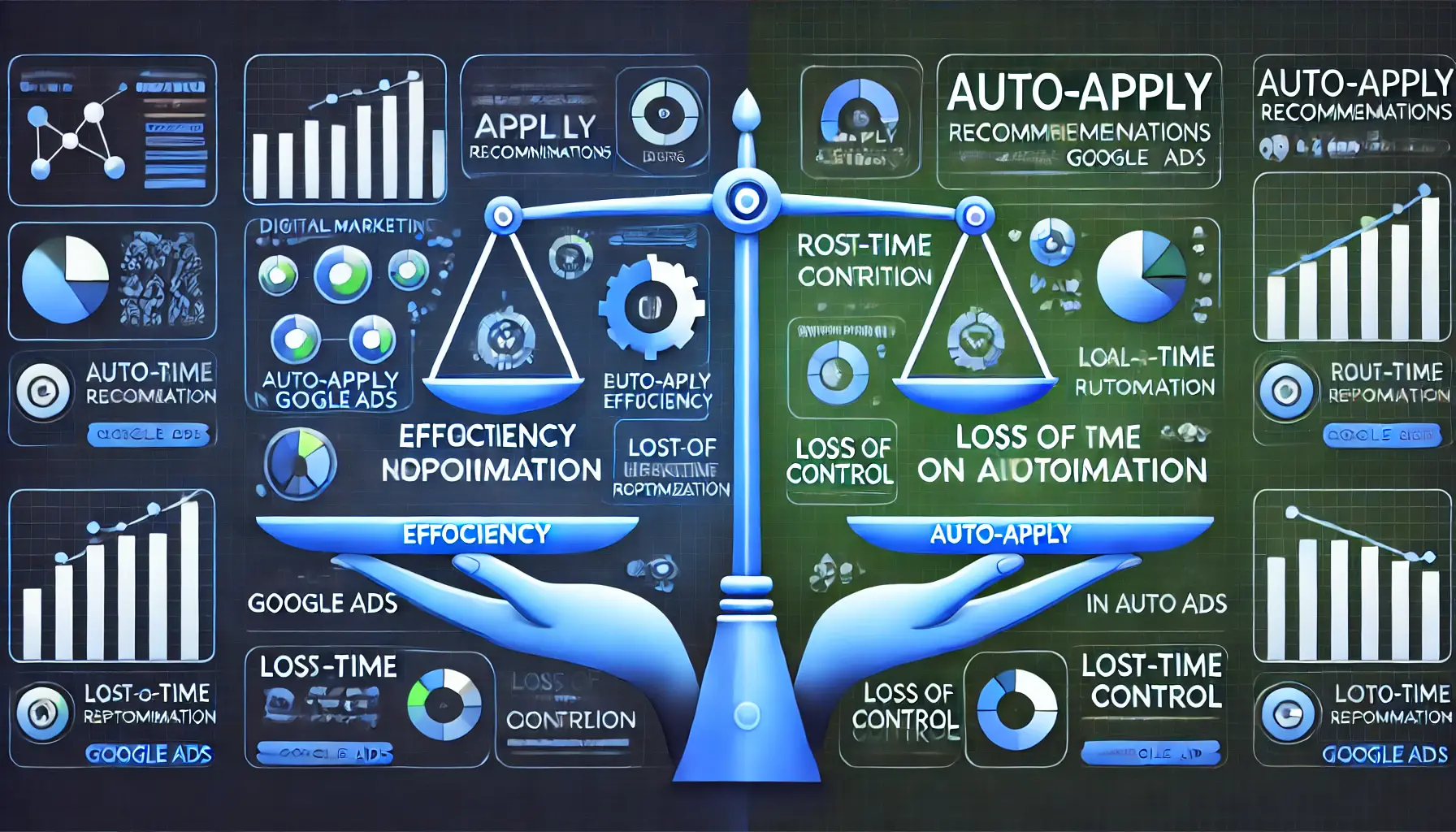
Balanced view of the pros and cons of using auto-apply recommendations in Google Ads for campaign management.
Pros and Cons of Auto-Apply Recommendations
Like any tool, Google Ads Auto-Apply Recommendations have several advantages and disadvantages.
While it can save you time and help optimize your campaigns, you should also be aware of the potential drawbacks so you can use this feature in the best way possible.
This section will highlight the pros and cons involved in using Auto-Apply Recommendations in your campaigns.

The benefits of using auto-apply recommendations in Google Ads, including time-saving automation and performance optimization.
Benefits of Using Auto-Apply Recommendations
There are several reasons why an advertiser would want to enable Auto-Apply Recommendations.
Here are the major advantages:
- Time-saving automation: One of the biggest benefits of Auto-Apply Recommendations is the time saved. Automation frees advertisers from manually intensive tasks like adjusting bids, budget reallocations, and keyword management, allowing more time for higher-value campaign optimization.
- Data-driven decisions: Google’s machine learning algorithms analyze vast amounts of data to make optimization suggestions. This means decisions are based on data, increasing your chances of making informed adjustments that drive results.
- Real-time adjustments: Auto-Apply Recommendations can respond to real-time market conditions and campaign performance. For example, if a campaign underperforms, Google might automatically adjust bids or keywords to prevent wasted spend and improve efficiency.
- Increased efficiency: By automating mundane tasks, Auto-Apply Recommendations help ensure that your campaigns remain competitive and run optimally, even when you don’t have the time for constant manual adjustments.

Illustration of potential risks like loss of control and over-reliance on automation in Google Ads auto-apply recommendations.
Potential Drawbacks and Risks
While Auto-Apply Recommendations offer many benefits, there are also some potential risks to consider:
- Loss of control: Automating certain decisions means giving up some control over your campaigns. While Google’s recommendations are data-backed, they may not always align perfectly with your objectives or strategy.
- Generic optimizations: Auto-Apply Recommendations are generalized and may not take into account the unique nuances of your brand, market, or audience, leading to less customized optimizations.
- Over-reliance on automation: While automation is convenient, relying too heavily on it can cause you to miss opportunities. Manual oversight is still needed to ensure your campaigns are optimized in a way that truly benefits your business.
- Limited transparency: Although Google provides reports on the changes made, it may not always be clear why certain recommendations were applied or how they fit into your overall strategy.
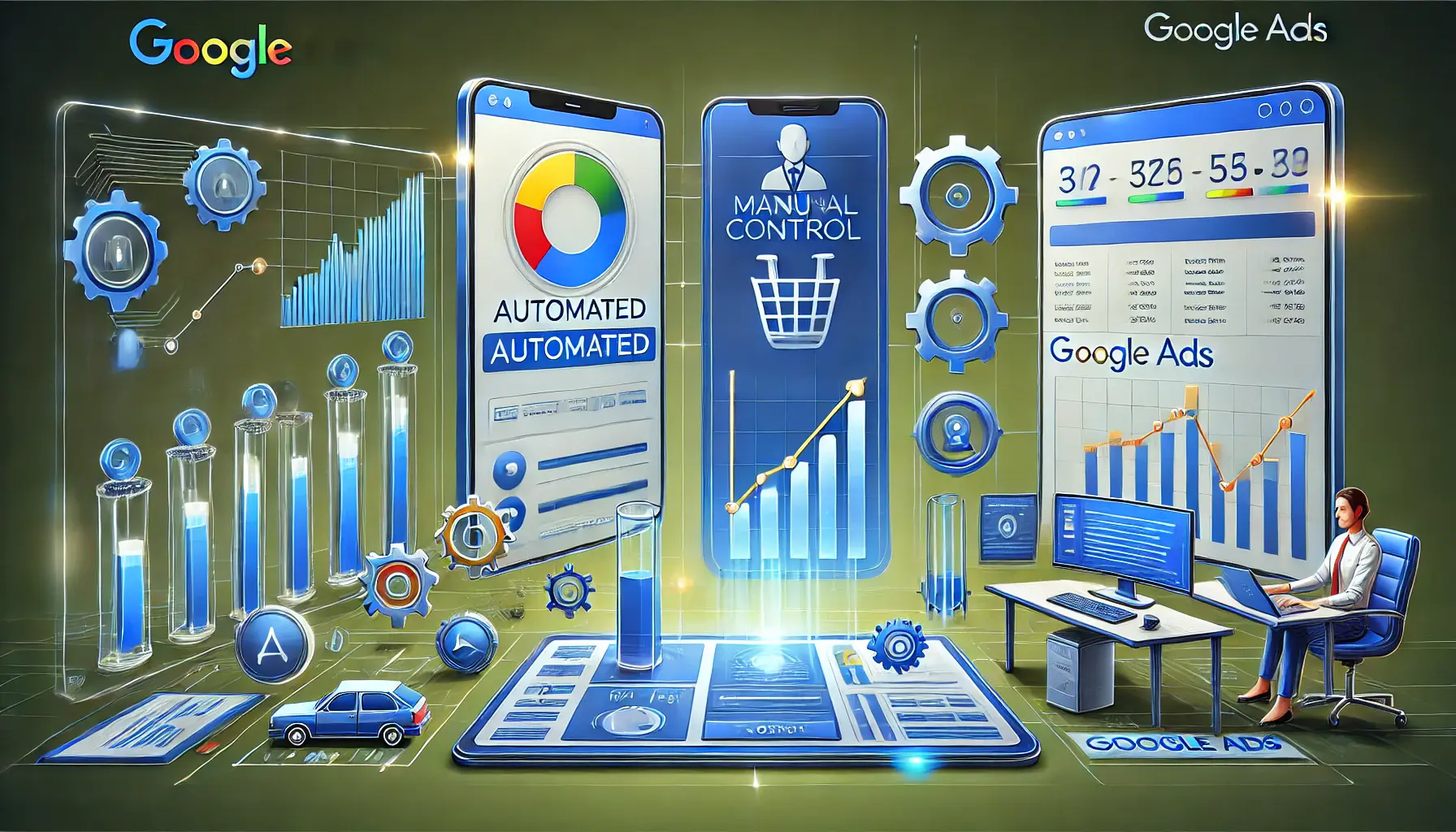
Illustration of balancing automation and manual control for optimized campaign management in Google Ads.
Balancing Automation and Manual Control
To maximize the potential of Auto-Apply Recommendations, you need to balance automation with manual control.
While this feature can optimize many aspects of your campaigns, it’s important to regularly review the applied recommendations to ensure they align with your broader marketing goals.
Here’s how you can maintain that balance:
- Use Auto-Apply for routine tasks: Automate tasks like bid adjustments, keyword recommendations, and budget reallocations, but maintain manual control over strategic elements such as ad copy and creatives.
- Set clear goals: Before enabling Auto-Apply Recommendations, define clear campaign goals to help select the right types of recommendations to automate.
- Monitor performance: Track the performance of automated changes regularly to ensure they deliver the expected results. Adjust recommendations manually if they don’t work as planned.
- Maintain oversight: Even with automation in place, strategic oversight is essential. Review the changes made and evaluate how they contribute to the overall success of your campaigns.
By carefully balancing automation with manual control, you can enjoy the advantages of Auto-Apply Recommendations while minimizing potential risks.
While Auto-Apply Recommendations offer convenience, over-reliance on them can lead to a loss of control, and generic optimizations may not fit every campaign’s unique needs.

Illustration of the best practices for leveraging auto-apply recommendations in Google Ads to optimize performance and efficiency.
Best Ways to Leverage Auto-Apply Recommendations
Leveraging Auto-Apply Recommendations effectively is all about strategy, ensuring that you utilize this feature without losing control to Google Ads automation.
By applying best practices, you can maximize the benefits of automation while improving the overall performance of your campaigns.
Below are some key best practices to apply when leveraging Auto-Apply Recommendations in your campaigns.
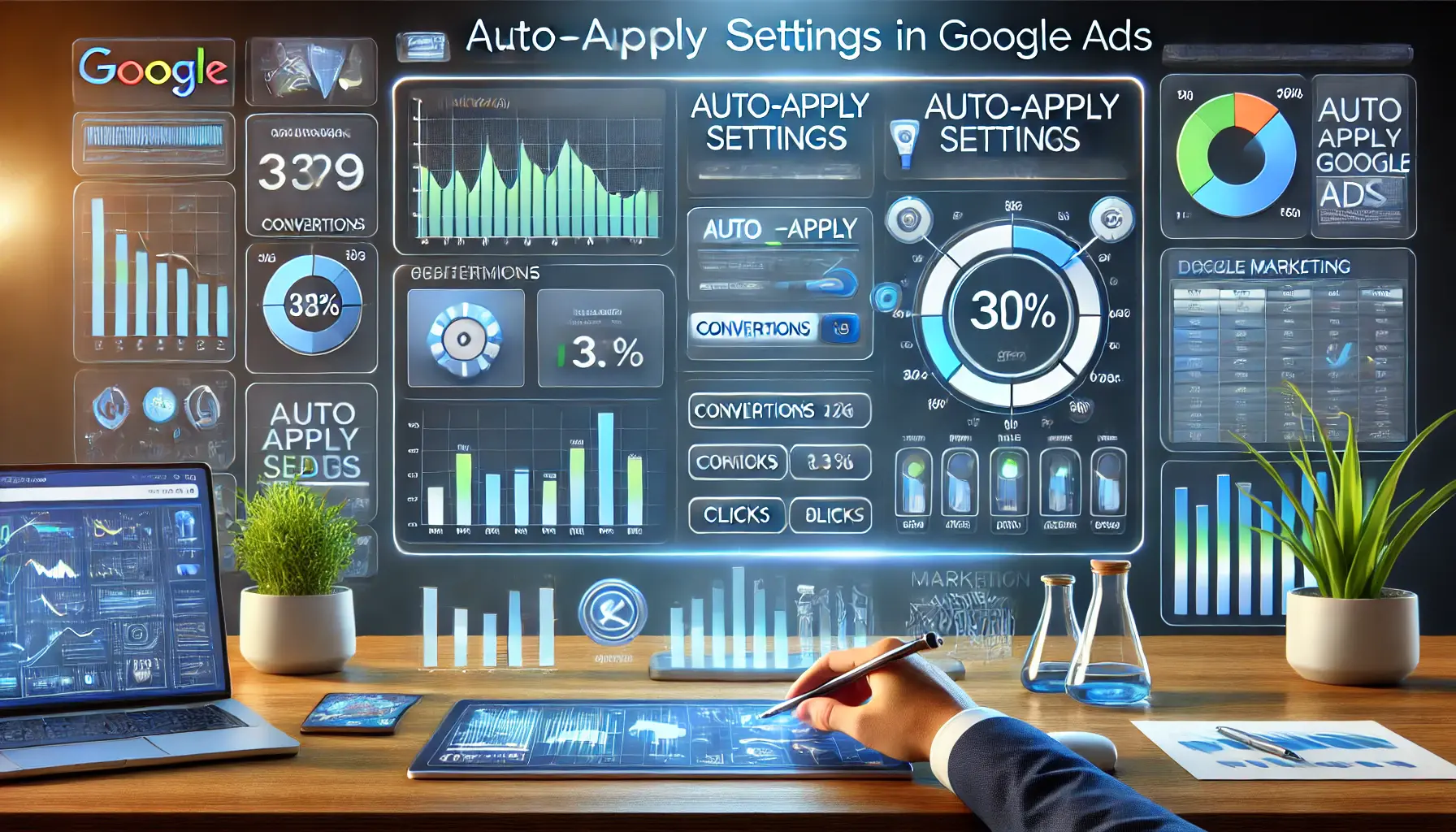
Illustration of optimizing auto-apply settings in Google Ads to align with specific campaign goals like conversions and budget efficiency.
Optimizing Auto-Apply Settings for Your Goals
Each campaign has its own objectives—some focus on maximizing conversions, some aim to increase click-through rates, while others need to manage ad spend within a specific boundary.
To make the most of Auto-Apply Recommendations, it’s essential to align automated recommendations with your campaign’s specific goals.
Here’s how you can optimize your settings:
- Review your current campaign objectives and select the recommendations that best match your goals, such as bid adjustments for Maximize Conversions or keyword suggestions for Increase Traffic.
- Customize your auto-apply settings to focus on recommendations that support your key performance indicators (KPIs).
- Regularly revisit and adjust your settings as your goals evolve to ensure you’re automating the right optimizations.
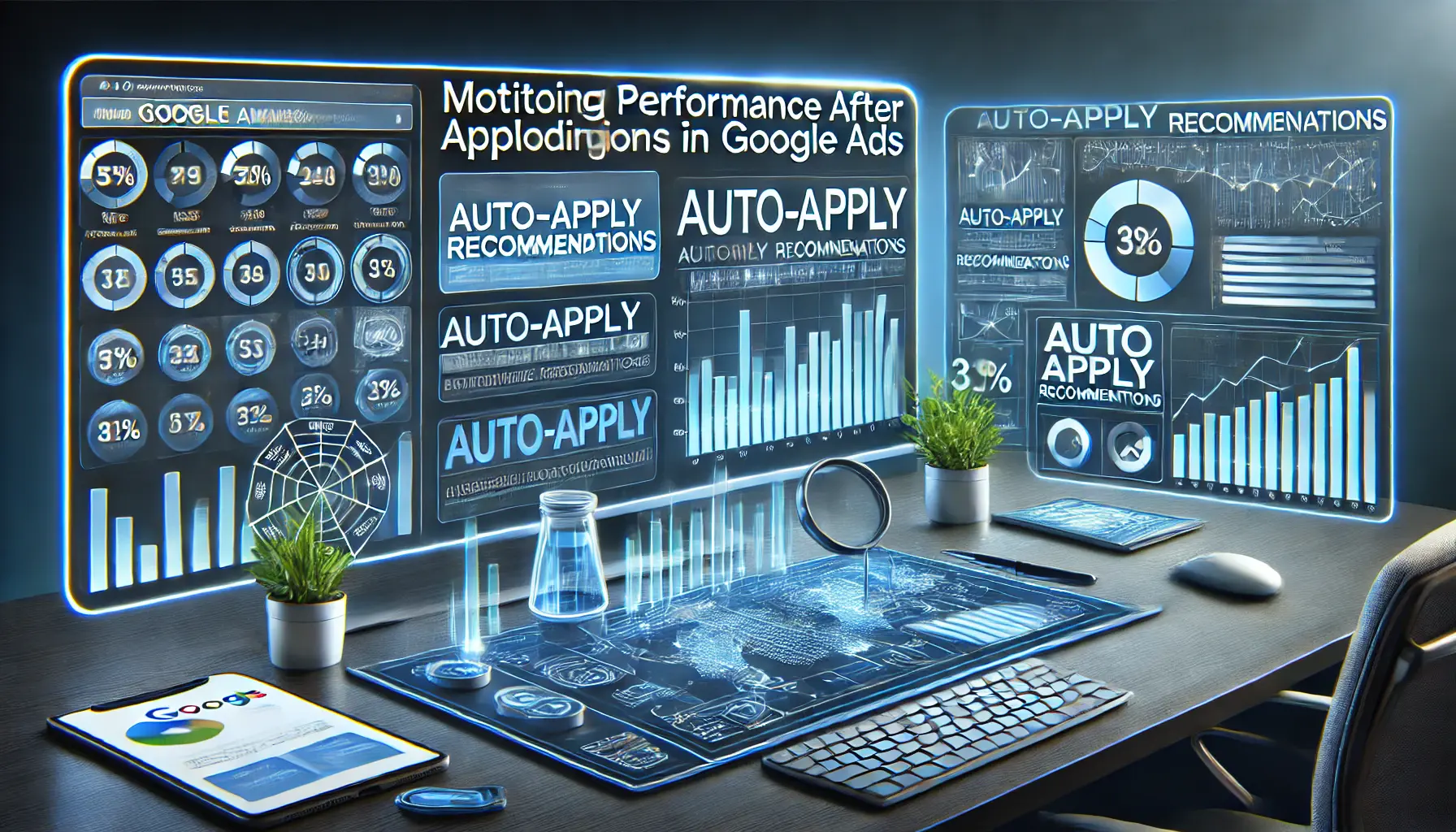
Tracking and monitoring performance after applying recommendations in Google Ads with real-time data and analytics.
Monitoring Performance After Applying Recommendations
While Auto-Apply Recommendations can automate most regular optimizations, it’s important to continuously monitor their performance.
Periodic reviews should be scheduled to ensure that the applied recommendations are yielding the desired results.
This ensures you can intervene when needed to make adjustments.
Here’s how you can monitor effectively:
- Review the Google Ads ‘Change History’ tab to track all automated changes and their impact on performance metrics such as conversions, click-through rates, and cost-per-click.
- Set a regular review schedule—weekly or biweekly—to ensure the changes are producing the desired outcomes. Adjust any changes manually if they do not yield the expected results.
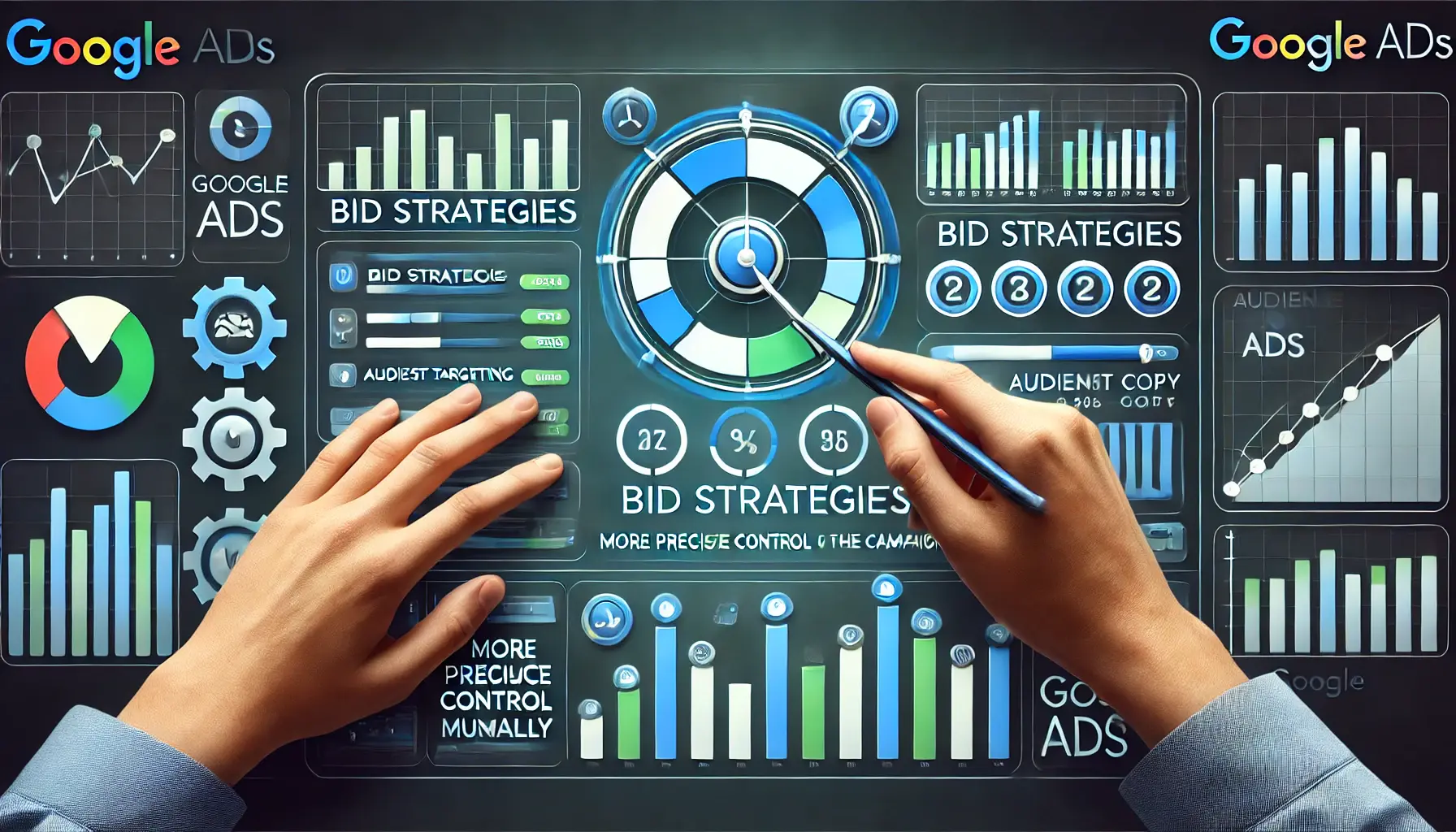
A scenario where manual adjustments are necessary for precise control over Google Ads campaigns.
When to Rely on Manual Adjustments Instead
Automation is a powerful tool, but there are times when manual intervention is necessary to keep your campaigns on track.
Knowing when to step in and override automated changes is key to maintaining strategic control.
Here are several situations where manual intervention would be more effective:
- When introducing new ad creatives or messaging, manual control ensures that your brand’s tone of voice is maintained and the content remains high quality.
- If you are running a time-sensitive promotion, manually adjusting bids or budgets can help you optimize performance during the promotional period.
- Targeting specific audience segments may require manual bid adjustments to more effectively reach high-priority groups than what automated systems might suggest.
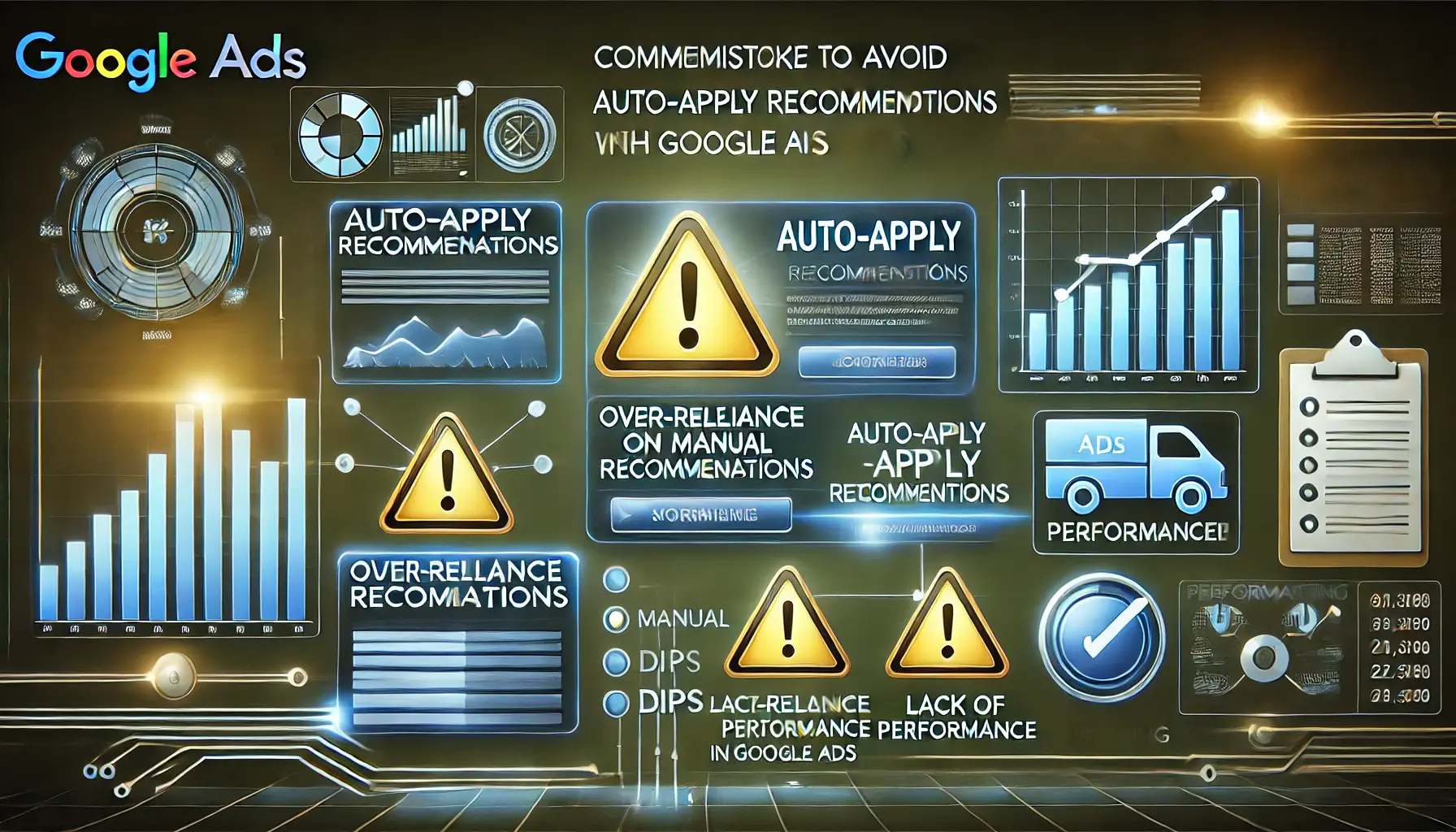
Illustration of strategies to avoid common mistakes when using auto-apply recommendations in Google Ads.
Avoiding Common Mistakes with Auto-Apply
Despite the advantages, advertisers sometimes make common mistakes when using Auto-Apply Recommendations, leading to suboptimal performance.
Here are some pitfalls to avoid for maximum benefit:
- Over-reliance on automation: Automation is powerful, but over-reliance on it without human oversight can lead to missed opportunities or misaligned strategies.
- Not monitoring results: Failing to regularly check the performance of Auto-Apply Recommendations can result in missed opportunities to correct issues before they negatively impact your campaign.
- Not customizing: Neglecting to customize auto-apply settings to fit your goals can lead to generic optimizations that don’t fully meet your campaign’s needs.
By following these best practices, you can make the most of Auto-Apply Recommendations, ensuring that your campaigns are both efficient and effective while maintaining the strategic control needed to meet your goals.
To fully leverage Auto-Apply Recommendations, regularly review performance, customize settings for specific goals, and balance automation with manual control where needed.

Illustration of maximizing campaign success through optimized settings and auto-apply recommendations in Google Ads.
Maximizing Campaign Success with Auto-Apply Recommendations
Auto-Apply Recommendations in Google Ads provide a competitive advantage for advertisers by automating key aspects of campaign management while maintaining control.
This feature allows businesses to save time, enhance efficiency, and optimize performance through data-driven changes.
However, achieving the right balance between automation and oversight is crucial to ensure your campaigns stay aligned with broader marketing objectives.
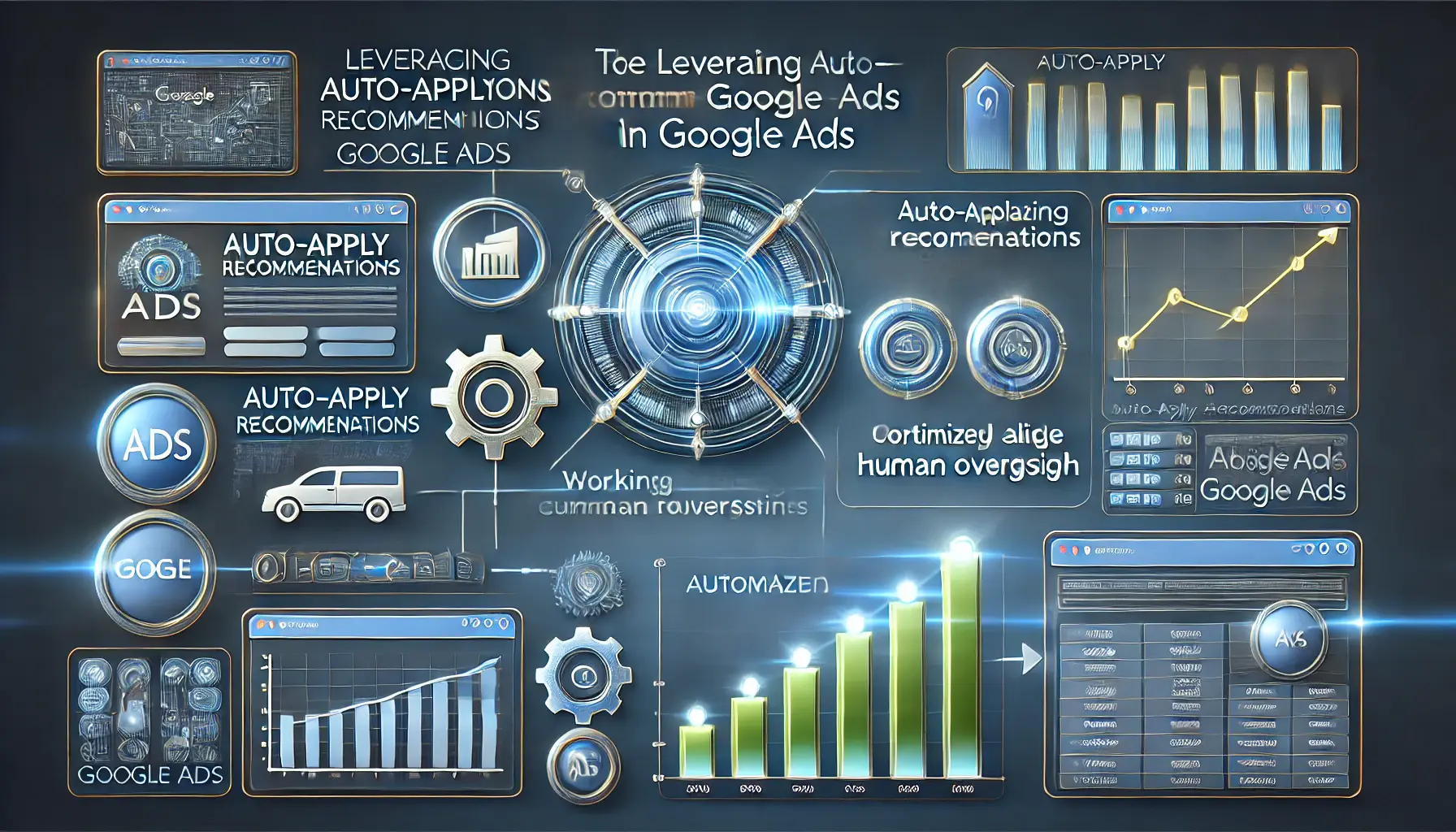
Illustration of the benefits of using auto-apply recommendations in Google Ads to optimize campaign performance and efficiency.
Benefits of Leveraging Auto-Apply Recommendations
In this article, we have highlighted several key benefits of utilizing Auto-Apply Recommendations, including:
- Time-saving automation: Automating routine tasks, such as bid adjustments and keyword management, frees up resources for higher-value tasks.
- Data-driven decisions: Google’s machine learning algorithms analyze vast amounts of data to present optimization suggestions that are highly relevant to your campaign.
- Real-time performance adjustments: Automated adjustments to bids and keywords help keep campaigns competitive and efficient in rapidly changing markets.
- Higher efficiency: Automation allows advertisers to maintain optimal campaign performance with less manual intervention.
While the benefits of Auto-Apply Recommendations are clear, maintaining a balance between automation and manual control is essential.
Sometimes, automated recommendations may not perfectly align with specific business objectives, which is why strategic oversight is crucial.
By customizing your auto-apply settings and regularly reviewing performance metrics, you can ensure that your automated changes align with your campaign goals.
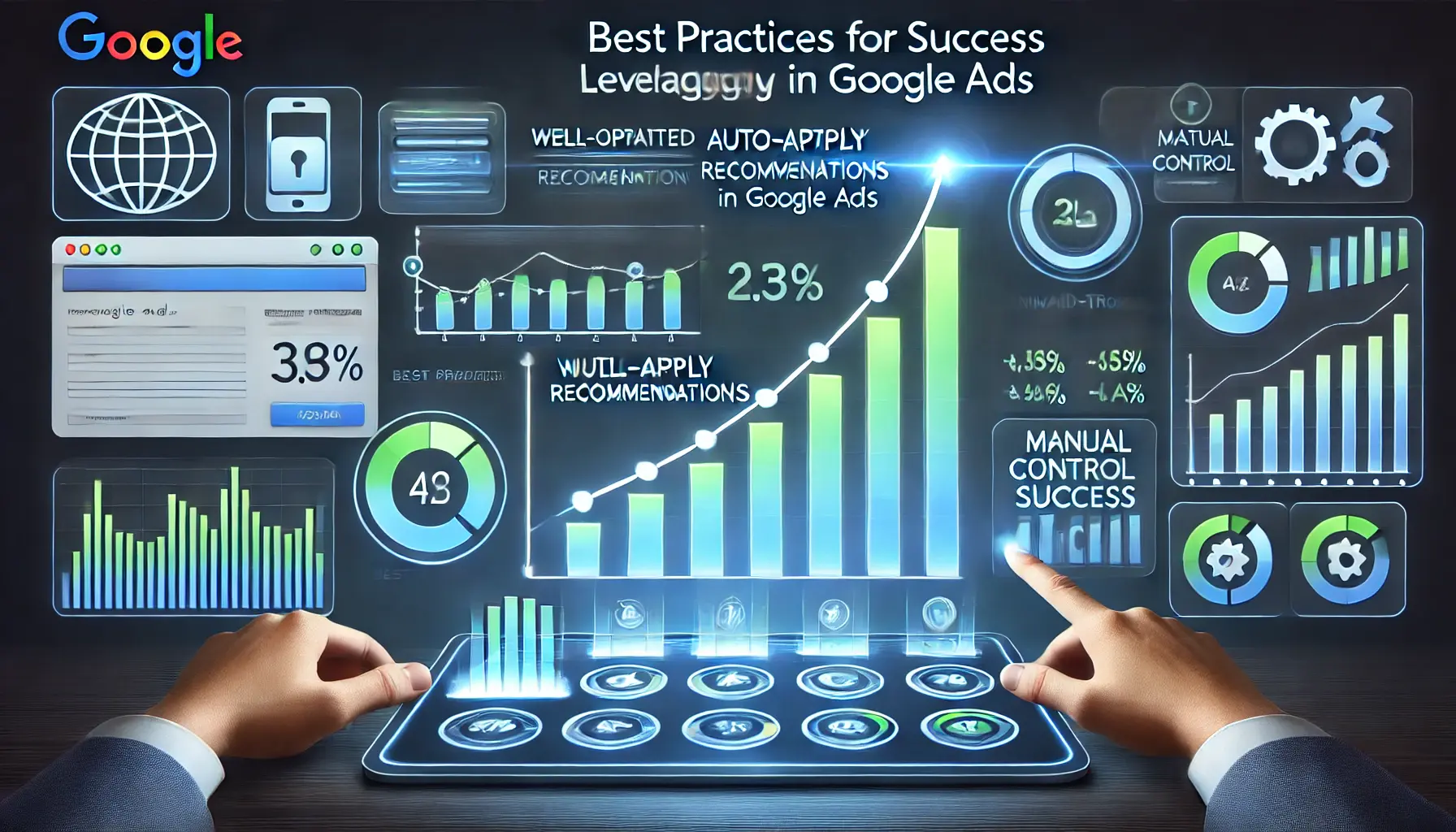
Illustration of best practices for leveraging auto-apply recommendations in Google Ads for optimized campaign success.
Best Practices for Success
Some best practices for leveraging Auto-Apply Recommendations include:
- Regularly reviewing and adjusting your auto-apply settings as your campaign goals evolve.
- Using the ‘Change History’ tab in Google Ads to monitor the impact of automated changes on performance metrics like conversions, click-through rates, and cost-per-click.
- Knowing when to make manual adjustments, particularly for creative elements and time-sensitive promotions.
- Avoiding over-reliance on automation by maintaining manual oversight to ensure you don’t miss opportunities or misalign strategies.

Illustration of common mistakes to avoid in Google Ads, including over-reliance on automation and lack of manual control.
Common Mistakes to Avoid
While Auto-Apply Recommendations can be highly beneficial, advertisers should avoid common pitfalls such as:
- Over-reliance on automation: Relying too heavily on automation without manual oversight can lead to missed opportunities and misaligned strategies.
- Failing to monitor results: Not regularly reviewing the performance of automated changes can result in suboptimal campaign outcomes.
- Neglecting customization: Failing to customize auto-apply settings may lead to general optimizations that don’t fully address your campaign’s unique needs.
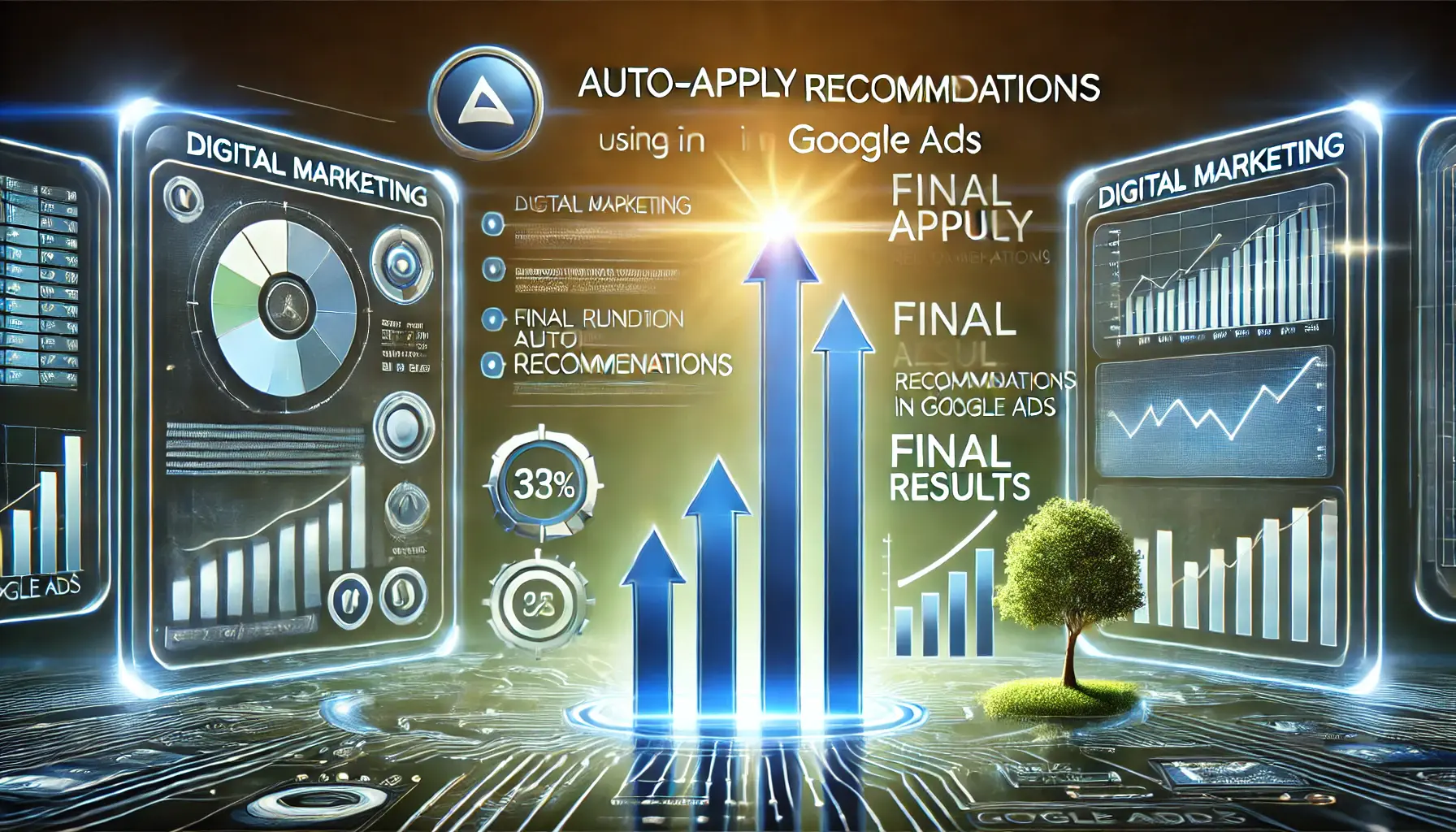
Illustration of the conclusion of a successful campaign using auto-apply recommendations, showcasing positive performance metrics and growth.
Conclusion
In conclusion, Auto-Apply Recommendations offer a powerful way to complement your Google Ads campaigns by automating routine tasks and making real-time, data-driven adjustments.
However, the most successful advertisers balance automation with manual control, ensuring that recommendations align with specific business goals.
By following best practices and customizing your settings, you can fully leverage the power of Auto-Apply Recommendations to achieve superior campaign performance.
Auto-Apply Recommendations maximize campaign efficiency, helping advertisers save time by automating repetitive tasks, but manual oversight is still crucial for strategic success.
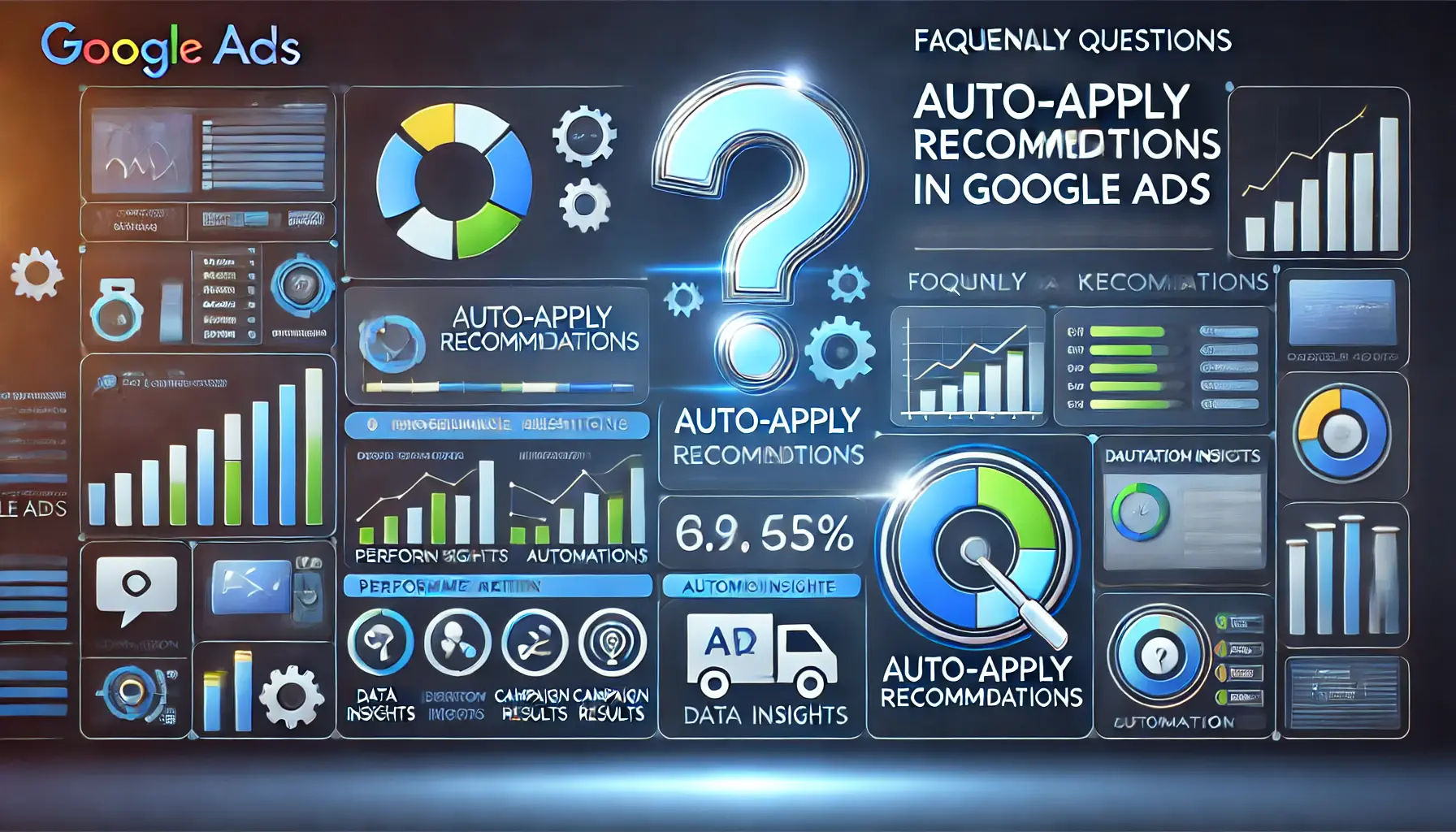
Illustration of frequently asked questions regarding auto-apply recommendations, showcasing performance metrics and data insights.
Your campaigns can be managed by an agency specialized in Google Ads, check out our service page.
Frequently Asked Questions About Auto-Apply Recommendations
Here are some of the most frequently asked questions about Auto-Apply Recommendations in Google Ads to give you a better understanding of how best to use the feature in your campaigns.
Auto-Apply Recommendations are automated suggestions in Google Ads that enhance campaign performance by optimizing bids, keywords, and budget using data-driven insights and real-time adjustments.
Yes, you can tailor Auto-Apply Recommendations by selecting which types of optimizations you want to automate, allowing you to retain control over the more strategic parts of your campaigns.
By automating tedious tasks, such as adjusting bids and managing keywords, Auto-Apply Recommendations free up time for higher-value tasks and strategic planning.
You can monitor the performance of Auto-Apply Recommendations through the ‘Change History’ tab in Google Ads, where detailed reports show the changes made and their impact on key metrics.
Over-relying on Auto-Apply Recommendations without human oversight can lead to missed opportunities, generic optimizations, and misalignment with your business strategy.
Manual intervention is recommended for tasks involving creative elements, time-sensitive promotions, or when targeting specific audience segments that require strategic adjustments not covered by automation.
Yes, you can turn off Auto-Apply Recommendations at any time through your Google Ads settings, allowing you to regain full manual control over your campaign adjustments and optimizations.
It is recommended to review the impact of auto-applied changes weekly or biweekly to ensure that the automated recommendations align with your ongoing campaign goals and produce positive results.
By default, Auto-Apply Recommendations do not affect ad copy or creative unless you specifically enable optimizations related to these elements in your Google Ads settings.



